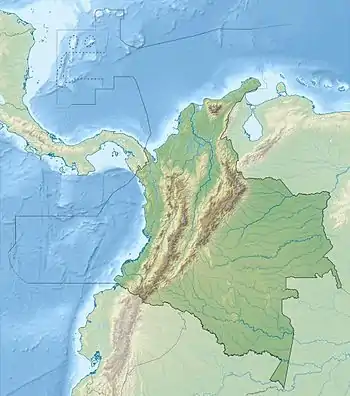| Paradracaena Temporal range: Miocene ~ | |
|---|---|
| Scientific classification | |
| Domain: | Eukaryota |
| Kingdom: | Animalia |
| Phylum: | Chordata |
| Class: | Reptilia |
| Order: | Squamata |
| Family: | Teiidae |
| Genus: | †Paradracaena |
| Species: | †P. colombiana |
| Binomial name | |
| †Paradracaena colombiana (Estes 1961) | |
| Synonyms | |
| |
Paradracaena is an extinct genus of lizards from northern South America. Fossils of Paradracaena colombiana have been found in the Honda Group of Colombia, Peru and Brazil . The species was described as a member of the tegus; Tupinambis huilensis by Estes in 1961.
Description

Paradracaena colombiana[1] was first described as Tupinambis huilensis by Estes in 1961, later named Dracaena colombiana by Sullivan and Estes in 1997.[2] These ground dwelling insectivore-carnivores were described from fossils found in fluvial and lacustrine clays of the Middle Miocene (Laventan in the SALMA classification) Villavieja Formation in Colombia.[3] They share a number of features with extant caiman lizards, such as large teeth and a robust quadrate, but also bear more primitive characteristics, such as a higher tooth count.[4]
Distribution
Apart from the type locality in the Honda Group, fossils attributed to the genus Paradracaena were recovered from the Pebas and Solimões Formations of the Amazon Basin of respectively Peru and Brazil.[5][6]
See also
References
- ↑ Dracaena colombiana at GBIF
- ↑ Sullivan & Estes, 1997, p.102
- ↑ Dracaena colombiana at Fossilworks.org
- ↑ Sullivan & Estes, 1997, p.111
- ↑ Pujos et al., 2009, p.594
- ↑ Hsiou et al., 2009, p.227
Bibliography
- Sullivan, Robert M., and Richard Estes. 1997. The Miocene Fauna of La Venta, Colombia - A reassessment of the fossil Tupinambinae, 100–112. Smithsonian Institution Press. Accessed 2019-03-21.
- Hsiou, Annie Schmaltz; Adriana María Albino, and Jorge Ferigolo. 2009. First Lizard Remains (Teiidae) from the Miocene of Brazil (Solimões Formation). Revista Brasileira de Paleontologia 12. 225–230. Accessed 2019-03-21.
- Pujos, François; Adriana M. Albino; Patrice Baby, and Jean-Loup Guyot. 2009. Presence of the Extinct Lizard Paradracaena (Teiidae) in the Middle Miocene of the Peruvian Amazon. Journal of Vertebrate Paleontology 29. 594–598. Accessed 2019-03-21.


